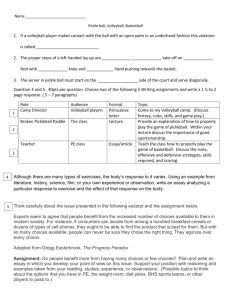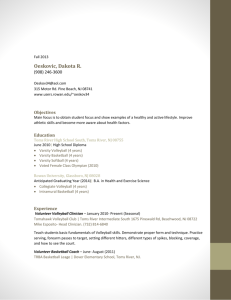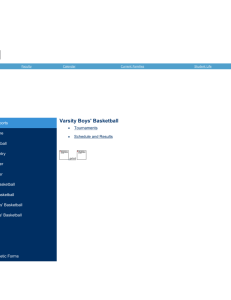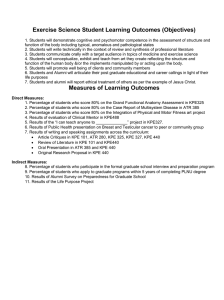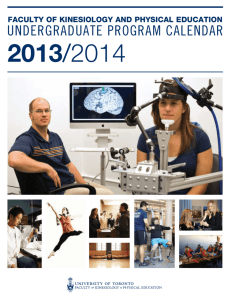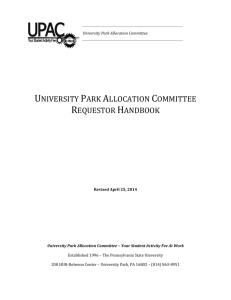OFFICIAL COURSE OUTLINE INFORMATION
advertisement
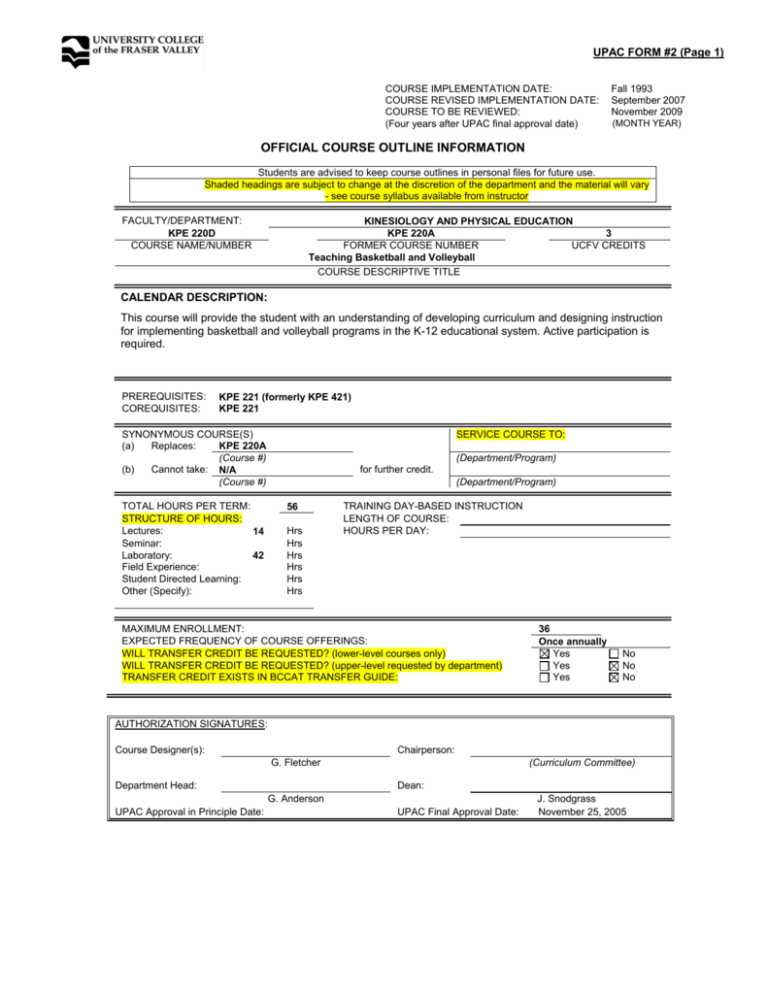
UPAC FORM #2 (Page 1) COURSE IMPLEMENTATION DATE: COURSE REVISED IMPLEMENTATION DATE: COURSE TO BE REVIEWED: (Four years after UPAC final approval date) Fall 1993 September 2007 November 2009 (MONTH YEAR) OFFICIAL COURSE OUTLINE INFORMATION Students are advised to keep course outlines in personal files for future use. Shaded headings are subject to change at the discretion of the department and the material will vary - see course syllabus available from instructor FACULTY/DEPARTMENT: KPE 220D COURSE NAME/NUMBER KINESIOLOGY AND PHYSICAL EDUCATION KPE 220A 3 FORMER COURSE NUMBER UCFV CREDITS Teaching Basketball and Volleyball COURSE DESCRIPTIVE TITLE CALENDAR DESCRIPTION: This course will provide the student with an understanding of developing curriculum and designing instruction for implementing basketball and volleyball programs in the K-12 educational system. Active participation is required. PREREQUISITES: COREQUISITES: KPE 221 (formerly KPE 421) KPE 221 SERVICE COURSE TO: SYNONYMOUS COURSE(S) (a) Replaces: KPE 220A (Course #) (b) Cannot take: N/A (Course #) TOTAL HOURS PER TERM: STRUCTURE OF HOURS: Lectures: 14 Seminar: Laboratory: 42 Field Experience: Student Directed Learning: Other (Specify): (Department/Program) for further credit. (Department/Program) 56 Hrs Hrs Hrs Hrs Hrs Hrs TRAINING DAY-BASED INSTRUCTION LENGTH OF COURSE: HOURS PER DAY: MAXIMUM ENROLLMENT: EXPECTED FREQUENCY OF COURSE OFFERINGS: WILL TRANSFER CREDIT BE REQUESTED? (lower-level courses only) WILL TRANSFER CREDIT BE REQUESTED? (upper-level requested by department) TRANSFER CREDIT EXISTS IN BCCAT TRANSFER GUIDE: 36 Once annually Yes Yes Yes No No No AUTHORIZATION SIGNATURES: Course Designer(s): Chairperson: G. Fletcher Department Head: (Curriculum Committee) Dean: G. Anderson UPAC Approval in Principle Date: UPAC Final Approval Date: J. Snodgrass November 25, 2005 KPE 220D COURSE NAME/NUMBER UPAC FORM #2 (Page 2) LEARNING OBJECTIVES / GOALS / OUTCOMES / LEARNING OUTCOMES: At the conclusion of the course, the student will be able to: 1.describe the conceptual nature of basketball and volleyball; 2.describe and demonstrate the techniques involved in the performance of basketball and volleyball; 3.demonstrate an understanding of the tactics and strategies involved in the performance of basketball and volleyball; 4.develop an effective skill progression for the teaching of individual skills; 5.exhibit a knowledge of both quantitative and qualitative analyses of the games of basketball and volleyball. METHODS: Lectures, Discussion, Demonstrations, Practical Applications and Experiences, Group Projects, Field Observations. PRIOR LEARNING ASSESSMENT RECOGNITION (PLAR): Credit can be awarded for this course through PLAR (Please check:) Yes No METHODS OF OBTAINING PLAR: Level II NCCP, practical and theory in both sports. TEXTBOOKS, REFERENCES, MATERIALS: [Textbook selection varies by instructor. An example of texts for this course might be:] Krause, J. (1991). Basketball Skills and Drills. Champaign, IL: Human Kinetics. Viera, B.L., & Ferguson, B.J. (1989). Volleyball: Steps to Success. Champaign, IL: Human Kinetics. SUPPLIES / MATERIALS: STUDENT EVALUATION: [An example of student evaluation for this course might be:] Exam #1 (Basketball) 25% Exam #2 25% Term Projects (2@10%) 20% In-Class Presentation (2@10%) 20% Class Participation/Performance 10% COURSE CONTENT: [Course content varies by instructor. An example of course content might be:] The course will be divided into two, 6-week sessions, with the first 6 weeks devoted to basketball and the second 6 weeks devoted to volleyball. The course outline for each session will be the same, as follows: I. Introduction to the Sport A. Historical Development of the Sport B. Terminology of the Sport C. Rule and Positional Concepts II. Individual Skill Techniques A. Individual Offensive Skills B. Individual Defensive Skills III. Team Tactics and Strategies A. Offense B. Defense C. Transitional Play IV. Analysis of Play A. Qualitative Analysis 1. Elements 2. Dimensions 3. Hierarchies a. Step b. Task B. Quantitative Analysis 1. Statistics 2. Flow 3. Time/Motion 4. Performance/Outcome Analysis
